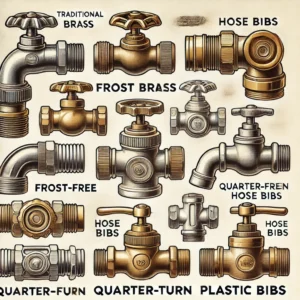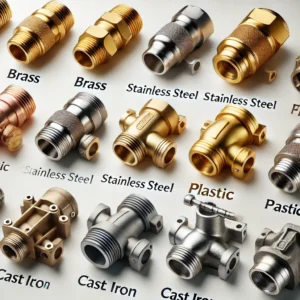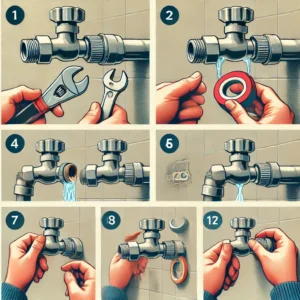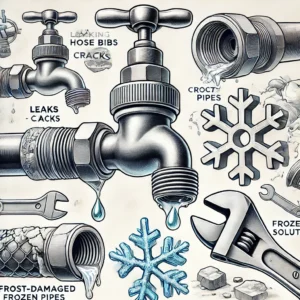Whatever You Required to Understand About Hose Bibs: The Important Overview
Hose bibs can be an overlooked part of the outside pipe system. You can easily connect your garden hose with the water supply when you want to clean your car or sprinkle your lawn.
The different types of water bibs will be covered in this comprehensive guide. Also, we’ll discuss maintenance and installation advice. This article will help you to make an informed decision for your home or business.
What is a Hose Bib?

A hose bib connects the outside faucet to a hose. It is mounted to the exterior of a building or house. You can control how much water flows into the hose. The hose is attached to a threaded and shutoff connection. Hose bibs provide reliable water for outdoor tasks like cleaning, watering and rinsing.
Hose bibs have to be durable, resistant to weather, and easy to use. The shutoff is usually controlled by a knob or handle. This allows you to adjust the water flow to your hose according to what’s needed.
Why Is a Hose Bib Important?
- While the hose bib is an easy component, it plays a crucial function in the capability of your home’s water supply. Below’s why a hose bib is vital:
Benefit:
- Hose bibs offer a practical water resource for outside jobs like sprinkling your yard, cleaning automobiles, or cleansing outside areas. With the capability to attach a hose, you can quickly gain access to water in position where interior pipes can not get to.
Effectiveness:
- Instead of transporting containers of water or relying upon a close-by interior tap, a hose bib permits continual water circulation, conserving effort and time. Upkeep of Landscaping: Having a hose bib set up makes certain that your plants, yard, or yard get the water they require to grow, also in dry spell problems or completely dry weather condition.
Home Care and Cleaning:
- Whether it’s cleaning your driveway, cleansing exterior furnishings, or filling a swimming pool, a hose bib gives a consistent and reputable water resource for all sort of home treatment tasks.
Sorts Of Hose Bibs:

There are a number of various sorts of hose bibs readily available, each made to fulfill particular demands. Recognizing the various kinds can aid you select the appropriate one for your application.
1. Requirement Hose Bib
- One of the most typical sort of hose bib, the common hose bib is usually made use of for day-to-day jobs. It includes a straightforward shutoff that activates and off to manage the water circulation. Criterion hose bibs can be made from a range of products, consisting of brass, steel, or plastic.
2. Frost-Free Hose Bib
- A frost-free hose bib is made to avoid cold throughout chilly winter season. This sort of hose bib is set up with a much longer shutoff stem, which maintains the shutoff inside the cozy component of your home’s pipes system. This makes certain that water does not ice up in the shutoff throughout freezing temperature levels, avoiding ruptured pipelines and expensive repair work.
3. Anti-Siphon Hose Bib
- An anti-siphon hose bib is made to stop water from streaming backwards right into your home’s water system. This sort of hose bib consists of an integrated heartburn preventer, which makes certain that infected water does not pollute your tidy water. Anti-siphon hose bibs are commonly called for in locations where watering or water reuse systems remain in area.
4. Angle Hose Bib
- An angle hose bib is developed to make linking pipes simpler in limited areas. These hose bibs are set up at a 90-degree angle, which enables the hose to link even more quickly without kinking or stressing the hose.
5. Wall-Mounted Hose Bib
- A wall-mounted hose bib is the basic installment for many homes. This sort of hose bib is straight attached to the wall surface, and it’s frequently seen on the outside of homes for outside water gain access to. It’s very easy to set up and gives trustworthy water for outside usage.
6. Lawn Hydrant
- A backyard hydrant is an advanced sort of hose bib, typically made use of in bigger homes, ranches, or commercial setups. A lawn hydrant is commonly set up in the ground and gives water accessibility at a greater stress. It’s suitable for areas where the supply of water requires to get to a higher range, such as farming locations or huge yards.
Hose Bib Materials:

Hose bibs are made from a selection of products, each using various degrees of toughness, price, and resistance to climate condition. The product you pick will certainly rely on your requirements and the environment in which you live.
1. Brass hose bibs
- Brass is the strongest material for hose bibs. The hose bibs made of brass are resistant to corrosion, which makes them ideal for outdoor usage. These items can withstand freezing temperatures better than anything else, making them an excellent choice in cooler climates.
2. Hose Bibs made of Stainless Steel
- In areas where there is a lot of humidity, stainless steel hose bibs are a great option. The stainless steel hose bibs will also withstand more damage than any other material.
3. Plastic Hose Bibs
- Plastic hose bibs are lightweight, but they may not last as well as steel versions. Although they are corrosion resistant, they may break in winter, particularly. Plastic hose-bibs can be used in light environments or for temporary purposes.
4. Aluminum Lightweight
- Light weight aluminum is not as durable as brass or stainless steel. Light weight aluminum can be used for applications which aren’t too heavy duty, but may not work well in areas that have high moisture levels..er.
Read About: Hose Barbs
Just how to Install a Hose Bib:

Setting up a hose bib is an uncomplicated procedure, however it’s vital to adhere to the proper actions to make certain a correct installment and prevent any type of leakages or problems.
Right here’s a basic detailed overview for mounting a hose bib:
Also one of the most sturdy hose bibs can encounter problems gradually. Right here are some usual troubles and easy remedies:.
- Products Needed:
- Hose bib
- Monkey wrench or flexible wrench
- Teflon tape (optional).
- Pipeline sealer (optional).
- Pipeline installations (if required).
Setup Steps:
Shut off the Water Supply.
- Prior to you start mounting your hose bib, shut off the water system to the location where you intend to mount the bib. This will certainly protect against any type of leakages or water damages throughout setup.
Prepare the Area.
- If you’re setting up a brand-new hose bib or changing an old one, eliminate the old component and clear the location around the pipeline where the hose bib will certainly be connected. You might require to make use of a wrench to loosen up any type of installations or accessories.
Apply Pipe Sealant.
- If you are utilizing pipeline sealer or Teflon tape, use it to the strings of the pipeline where the hose bib will certainly link. This assists make sure a leak-proof seal.
Affix the Hose Bib.
- Screw the hose bib onto the pipeline, ensuring the strings are correctly straightened. Tighten up the link with a monkey wrench or flexible wrench, however prevent over-tightening, which can create damages to the strings.
Look for Leaks.
- Transform the water system back on and evaluate the hose bib for leakages. If you discover any kind of water leaking from the link, tighten up the installations a little bit much more or include extra sealer.
Connect the Hose.
- When the hose bib is set up and devoid of leakages, connect your yard hose and begin utilizing it as required.
Typical Problems with Hose Bibs and How to Fix Them.

1. Dripping Hose Bib.
- A dripping hose bib can be brought on by damaged washing machines, loosened links, or harmed strings. Tighten up the links, change the washing machine, or reapply pipeline sealer as needed to deal with the leakage.
2. Icy Hose Bib.
- In cooler environments, hose bibs can ice up throughout the winter season, creating them to fracture or rupture. To stop cold, think about setting up a frost-free hose bib or separating the hose throughout winter season.
3. Low Tide Pressure.
- Low tide stress from a hose bib can be brought on by particles or mineral accumulation inside the shutoff. Tidy the shutoff or change the hose bib if needed to bring back water stress.
4. No Water Flow.
- If there’s no water circulation from the hose bib, check to make sure the shutoff is totally open which the water system is activated. If the concern continues, there might be a clog in the pipeline or an issue with the water system.
Conclusion:
A hose bib might be a tiny and easy component, yet it plays a large duty in supplying simple accessibility to water for outside jobs. From sprinkling your yard to cleaning your auto, hose bibs make life a lot more hassle-free. By comprehending the various kinds, products, and setup actions, you can pick the appropriate hose bib for your requirements and maintain it in excellent functioning order for several years ahead. Whether you’re a property owner, garden enthusiast, or company owner, a well-installed and kept hose bib will certainly offer you dependably for lots of exterior jobs. Verdict.